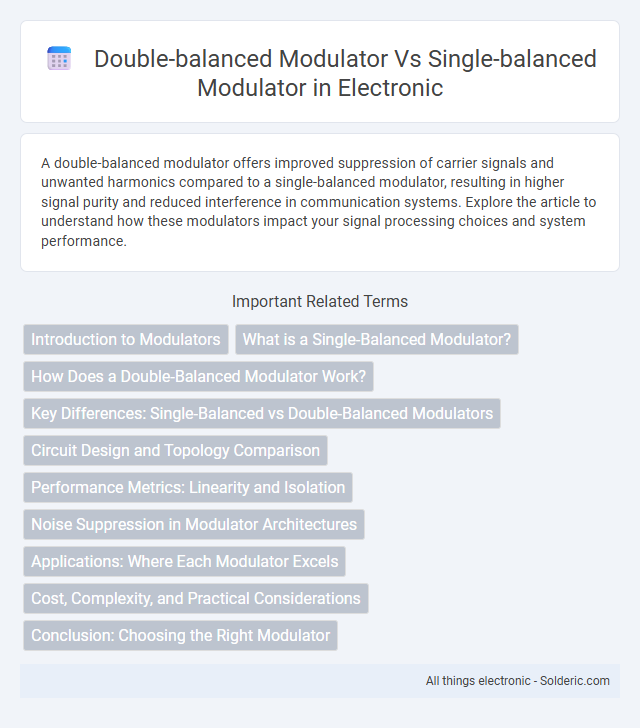A double-balanced modulator offers improved suppression of carrier signals and unwanted harmonics compared to a single-balanced modulator, resulting in higher signal purity and reduced interference in communication systems. Explore the article to understand how these modulators impact your signal processing choices and system performance.
Comparison Table
| Feature | Double-Balanced Modulator | Single-Balanced Modulator |
|---|---|---|
| Number of Balanced Ports | Two (both inputs balanced) | One (usually RF port balanced) |
| Carrier Suppression | High carrier suppression | Partial carrier suppression |
| Output Signal Purity | Low distortion, fewer harmonics | Higher distortion, more harmonics |
| Isolation Between Ports | Excellent isolation | Moderate isolation |
| Complexity and Cost | Higher complexity and cost | Lower complexity and cost |
| Typical Applications | Mixers, modulators in communication systems requiring low distortion | Basic modulation and mixing with moderate performance needs |
Introduction to Modulators
Double-balanced modulators provide superior suppression of carrier and unwanted sidebands compared to single-balanced modulators, making them ideal for applications requiring high signal integrity. Single-balanced modulators, while simpler and more cost-effective, only suppress one unwanted signal component, which can result in increased distortion and noise. Your choice between these modulators depends on the balance between performance needs and system complexity.
What is a Single-Balanced Modulator?
A single-balanced modulator suppresses either the carrier or one sideband but not both, resulting in partial cancellation of unwanted signals. It typically uses one balanced element like a mixer or a pair of diodes to achieve better carrier suppression than unbalanced modulators. Single-balanced modulators are simpler and have lower complexity compared to double-balanced modulators, which provide superior suppression of both carrier and unwanted sidebands.
How Does a Double-Balanced Modulator Work?
A double-balanced modulator works by suppressing both the carrier signal and unwanted sidebands, allowing only the desired modulated output to pass through, achieved through the use of four diodes or transistors arranged in a ring configuration. This design provides higher isolation between input ports compared to a single-balanced modulator, which only suppresses the carrier and requires fewer components but allows some carrier leakage. Your choice of modulator impacts signal purity and suppression levels in applications such as RF communication and signal processing.
Key Differences: Single-Balanced vs Double-Balanced Modulators
Double-balanced modulators offer superior isolation between input signals compared to single-balanced modulators, reducing carrier leakage and enhancing signal purity. Single-balanced modulators cancel only one input signal while allowing some feedthrough of the other, making them simpler but less effective in noise suppression. Your choice depends on the required signal isolation and complexity, with double-balanced modulators preferred for high-performance communication systems.
Circuit Design and Topology Comparison
Double-balanced modulators feature a circuit topology incorporating two balanced mixers and transformers, which effectively suppress both the carrier and unwanted harmonics, resulting in higher isolation between ports. Single-balanced modulators use one balanced mixer combined with an unbalanced path, achieving partial carrier suppression but with increased leakage and lower signal purity. The double-balanced design typically involves complex transformer arrangements such as the ring modulator, whereas single-balanced circuits rely on simpler, fewer components but offer reduced performance in terms of isolation and distortion.
Performance Metrics: Linearity and Isolation
Double-balanced modulators offer superior linearity compared to single-balanced modulators due to their inherent cancellation of even-order harmonics, resulting in lower distortion and improved signal integrity. Isolation between ports in double-balanced modulators is significantly higher, minimizing feedthrough of the carrier and modulating signals, which enhances overall system performance. Your choice depends on the application's need for precision, with double-balanced modulators being ideal for environments requiring stringent linearity and isolation metrics.
Noise Suppression in Modulator Architectures
Double-balanced modulators offer superior noise suppression compared to single-balanced modulators due to their ability to cancel out both carrier leakage and even-order harmonics, resulting in lower intermodulation distortion and improved signal integrity. Single-balanced modulators typically suppress only one side of the carrier signal, leading to higher residual carrier and increased noise levels. The architecture of double-balanced modulators inherently minimizes noise contributions from local oscillator feedthrough, enhancing overall system performance in communication and signal processing applications.
Applications: Where Each Modulator Excels
Double-balanced modulators excel in applications requiring high isolation between ports, such as in high-frequency mixers used within radio communication systems and phase detectors in instrumentation. Single-balanced modulators are preferred in simpler circuits where cost and complexity must be minimized, typically in amplitude modulation for audio transmission and basic signal processing. The choice depends on the trade-off between performance, such as suppression of unwanted signals, and implementation constraints.
Cost, Complexity, and Practical Considerations
Double-balanced modulators generally exhibit higher complexity and cost due to their intricate design involving four diodes or transistors, which enhances suppression of carrier and unwanted signals. Single-balanced modulators, with a simpler two-diode or transistor structure, offer lower cost and reduced circuit complexity but suffer from less effective carrier suppression, impacting overall signal purity. In practical applications, double-balanced modulators are preferred for high-performance requirements despite higher expense, while single-balanced options suit cost-sensitive or less demanding tasks.
Conclusion: Choosing the Right Modulator
Double-balanced modulators offer superior suppression of carrier signals and even-order harmonics compared to single-balanced modulators, providing higher purity in signal modulation essential for advanced communication systems. Single-balanced modulators, while simpler and more cost-effective, exhibit less carrier rejection and higher distortion, making them suitable for less demanding applications. Selecting the right modulator depends on balancing performance requirements, system complexity, and budget constraints, with double-balanced modulators preferred for high-fidelity signal processing.
Double-balanced modulator vs single-balanced modulator Infographic

 solderic.com
solderic.com